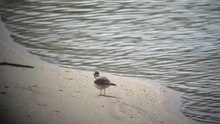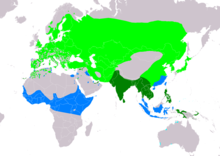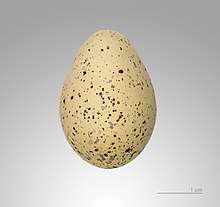Little ringed plover
| Little ringed plover | ||||||||||
|---|---|---|---|---|---|---|---|---|---|---|

Little ringed plover ( Charadrius dubius ) |
||||||||||
| Systematics | ||||||||||
|
||||||||||
| Scientific name | ||||||||||
| Charadrius dubius | ||||||||||
| Scopoli , 1786 |
The ringed plover ( Charadrius dubius ) is a species of bird from the family of Plover (Charadriidae). In Central Europe, the little ringed plover is a widespread, but less common breeding and summer bird. During migration, it can be seen relatively often as a migrant and resting bird.
description
A fully grown little ringed plover grows to 15 to 18 cm and weighs 25 to 55 g. The wingspan reaches 34 to 45 cm. The little ringed plover differs from the very similar ringed plover in its smaller and slimmer appearance. It also has a darker beak and striking yellow circles under the eyes, which the Ringed Plover lacks.
Its back is brown and its underside is colored white. The short beak is dark and its legs are brown-yellow in color. The little ringed plover has black eyes with a yellow eye ring. The front part of the head is drawn in black and white. The little ringed plover also has a black collar. Males and females have the same coloration. His call sounds like “piu” or “pri”.
habitat
The little ringed plover lives on mud , sand , gravel surfaces and on quarry ponds in almost all of Europe (except Scotland , Ireland , Norway and Iceland ). Quarry ponds and gravel pits are mostly just alternative options, since there are very few natural rivers with gravel banks.
In the winter from November to February, the long-haul migrant, who mainly flies to their winter quarters at night, is a guest in the Mediterranean and Africa . The wintering quarters include the south of the Sahara to the coast of West Africa, Zaire, Tanzania and Kenya. However, only a few migratory birds cross the equator. The wintering quarters also include Egypt and, occasionally, the Mediterranean region.
nutrition
The little ringed plover feeds on worms , spiders , insects , larvae and mollusks, as well as other animals living close to the surface of the ground. It usually looks for its food in the shallow, muddy banks of fresh waters. Unlike the ringed plover, it can only be seen very rarely on the coast. The food is picked from the surface of the water or from the bottom.
Reproduction
The breeding season extends from April to July. The nest is a hollow in the ground and is laid out with parts of plants and other materials. It is found in open ground or in low vegetation and is rarely far from the water. Often, small islands in a lake or river are used as nesting sites. During courtship, the male creates several shallow hollows, of which the female then chooses one as a nest.
The female lays four eggs , which are well camouflaged by their color pattern. The shell color is stone gray to cream with small brown spots and dots. The incubation period is 24 to 25 days. Both parent birds are involved in the brood. In the event of imminent danger, the parents lure the attacker in a different direction by means of behavior called enticing and thus try to protect their young.
Central European breeding pairs often raise two broods.
Duration
The European population of little ringed plovers decreased significantly towards the end of the 19th century and the beginning of the 20th century. Climate change was probably responsible for this. The numerous, very rainy summers of these years reduced the number of possible nesting sites due to increased water levels. Both the European population and the distribution have increased since the 1930s, presumably due to a series of dry summers. Towards the end of the 20th century, gravel extraction in particular increased the number of possible nesting sites.
The total European population is estimated at around 110,000 to 240,000 breeding pairs at the beginning of the 21st century. European countries with a population of more than 5,000 breeding pairs are Russia (European part), Belarus, Ukraine, France and Germany. Little ringed plovers breed in all Central European countries, although they only occur in exceptional cases in the low mountain ranges and the Alps and do not exceed altitudes of more than 800–900 meters above sea level. The Central European total population is estimated at around 13,000 to 19,500 breeding birds. At the beginning of the 21st century, 4,300 to 6,800 breeding pairs were breeding in Germany. Germany thus has the highest breeding pair population of all Central European countries.
Others
The little ringed plover was bird of the year 1993 .
Subspecies
There are three known subspecies:
- Charadrius dubius curonicus Gmelin, JF , 1789 occurs in northern Africa, Europe and Asia with the exception of the southern central and southeastern parts of Asia.
- Charadrius dubius jerdoni ( Legge , 1880) is distributed from India to southern China and Indochina .
- Charadrius dubius dubius Scopoli , 1786 occurs in the Philippines as far as New Guinea and the Bismarck Archipelago .
supporting documents
literature
- Hans-Günther Bauer, Einhard Bezzel and Wolfgang Fiedler (eds.): The compendium of birds in Central Europe: Everything about biology, endangerment and protection. Volume 1: Nonpasseriformes - non-sparrow birds. Aula-Verlag Wiebelsheim, Wiesbaden 2005, ISBN 3-89104-647-2 .
- Peter Colston , Philip Burton: Limicolen - All European wader species, identifiers, flight images, biology, distribution. BLV Verlagsgesellschaft, Munich 1989, ISBN 3-405-13647-4
- Simon Delany, Derek Scott, Tim Dodman, David Stroud (Eds.): An Atlas of Wader Populations in Africa and Western Eurasia. Wetlands International , Wageningen 2009, ISBN 978-90-5882-047-1 .
- Giovanni Antonio Scopoli: Deliciae Florae Et Faunae Insubricae Seu Novae, Aut Minus Cognitae Species Plantarum Et Animalium, Quas In Insubria Austriaca Tam Spontaneas, Quam Exoticas Vidit, Descripsit, et Aeri Incidi Curavit . tape 2 . Ex Typographia Reg. & Imp. Monasterii S. Salvatoris. Praesidib. Rei litter. permittentibus, Ticini 1786 ( gdz.sub.uni-goettingen.de ).
- Johann Friedrich Gmelin: Systema Naturae per Regna Tria Naturae, Secundum Classes, Ordines, Genera, Species, Cum Characteribus, Differentiis, Synonymis, Locis . tape 1 , no. 2 . Georg Emanuel Beer, Leipzig 1789 ( biodiversitylibrary.org ).
- William Vincent Legge: Capitain WV Legge, RA, exhibited a series of specimens of Little Ringed Plovers from Ceylon and Central India . In: Proceedings of the Scientific Meetings of the Zoological Society of London for the Year 1880 . 1880, p. 38-39 ( biodiversitylibrary.org ).
Individual evidence
Web links
- Little ringed plover at the Federal Agency for Nature Conservation (NaturSportInfo)
- Interesting photos of the little ringed plover in high quality.
- The Little Ringed Plover Image documentation from Lake Neusiedl
- Charadrius dubius in the endangered Red List species the IUCN 2008. Posted by: BirdLife International, 2008. Accessed on December 23 of 2008.
- Videos, photos and sound recordings of Charadrius dubius in the Internet Bird Collection
- Age and gender characteristics (PDF; 5.4 MB) by J. Blasco-Zumeta and G.-M. Heinze (Eng.)
- Little ringed plover feathers







